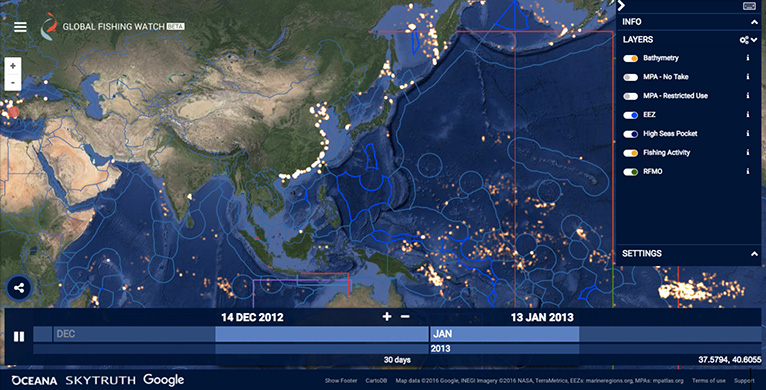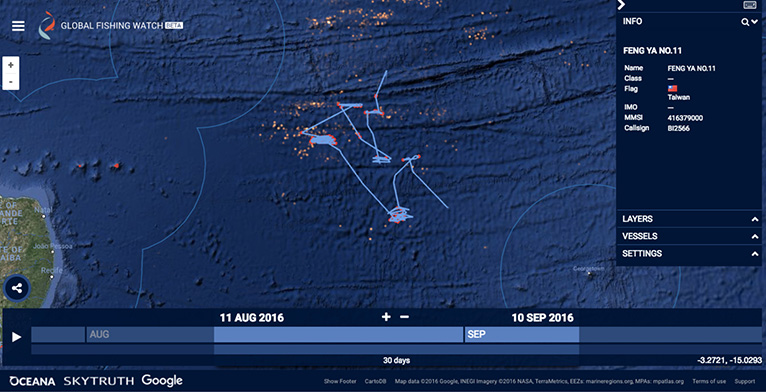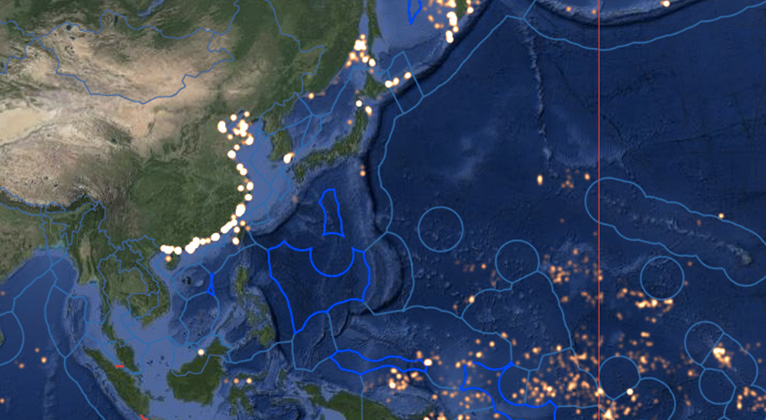If Global Fishing Watch is unlikely to be used by ordinary citizens of the countries most affected by illegal fishing, why is it marketed like a neighborhood watch tool?
AT John Kerry’s 2014 “Our Ocean” conference, a tuxedoed Leonardo DiCaprio introduced a new technology that promised to end illegal fishing across the globe. Global Fishing Watch boasted real-time monitoring of the world’s ships. This machine-learning spy tool was the result of a collaboration between the conservation advocacy organization Oceana, the satellite surveillance firm SkyTruth, and Google. After it collects and maps vessel location data transmitted from onboard satellite tracking devices, the program organizes all data points on a user-friendly Internet platform. For the first time in history, all fishing activity is recorded--even on the high seas that lie outside national jurisdictions. With Global Fishing Watch’s all-seeing gaze, states can adjudicate crimes to which they were previously blind.
Fishing without a license, over a quota, in a protected area, with prohibited gear, or of endangered species is illegal--meaning they violate the law of either a coastal state or the Regional Fishery Management Organization (RFMO), which is a group of nations that coordinates fisheries management in a particular region. It is illegal for a vessel not to report, or to underreport, its catch. Unregulated fishing, which occurs on the high seas outside an RFMO area or on vessels without a national flag, occupies an uneasy gray area: it cannot be criminal because it is out of the law’s reach. But fishers on unregulated vessels tend to engage in a range of criminal activities upon returning to national waters, from forging ship’s logs to smuggling humans.
According to the United Nations 2009 Agreement on Port State Measures, preventing illegal fishing is about responsible resource extraction. Illegal fishers use damaging methods such as driftnets and dynamite that destroy reefs and turn tuna and dolphins into bycatch; they confound fishery managers’ prescription of quotas, which protect small-scale fishers whose livelihoods depend on the sustainability of marine ecosystems; they avoid the costs of doing business; and they are often unfair employers. A growing slave economy populated by Cambodian and Vietnamese migrants, for example, fills the labor shortage in the Thai fishing industry. The farther the vessels fish from shore, the more brutal the labor practices become: throwing the sick overboard, neck-shackling, beheading. These pirates--individuals who commit violent acts on the high seas for economic gain--operate at the seams of national control, poised to evade authorities by opportunistically hopping imaginary lines in the ocean. Ostensibly, it is these social and economic costs that compel state response.
The history of the shared prerogative of ocean stewardship among nations, however, tells a more complex story. The modern concept of the nation is tied to a deep anxiety surrounding the high seas. For almost a century, this anxiety has persisted irrespective of the criminal activity that takes place there. States are always anxious about their borders, but high seas represent a unique vulnerability. Within these fissures in the world order, pirates disavow the nation by challenging the global schema of contiguous, centrally-governed parcels of space. This disavowal, not the violent act in itself, is the true source of states’ anxiety. Global Fishing Watch retaliates by making national arbitration omnipresent. It locates the pirate, whose fate then lies with the state.
From 1929 to 1932, twenty-six white American men drafted laws that would come to govern the planet’s oceans. These professors, convened by the Harvard School of Law, were on assignment from the U.N.-precursor, the League of Nations, which spearheaded the project of building modern international law. In 1926, the League had sent questionnaires to its member governments in order to determine global issues that were “ripe for codification.” Oceans loomed large. The first priority, nationality, was followed by territorial waters. Piracy was ranked sixth; exploitation of products of the sea, seventh.
This preoccupation with the oceans was not instigated by any increase in maritime malfeasance. Throughout the 19th century, colonial governments from France in North Africa, to Spain, England, and the Netherlands in Southeast Asia made their best attempts to crush littoral raiding societies. They deployed steam-powered warships to raze pirate bases from Rabat to Borneo, and struck deals with double-dealing elites who could influence raiders. Their efforts appeared successful: by the 1930s, piracy was at an all-time low. Commercial fishing hadn’t yet evolved to a scale that could make or break economies, and the first offshore oil rig, drilled in 1947, wasn’t yet thinkable. Despite this period of relative calm, governments were uneasy.
As long as some crimes remained hidden from the eyes of all states, national borders were a farce. The pirate, albeit an anachronism, had morphed into a salient legal concept. Admiralty law’s hostis humani generis implied that pirates were beyond the law’s protection, encouraging ship captains to circumvent the judicial process entirely and execute them at sea. Such lawlessness was unacceptable at the League conventions, which sought to govern all space. And yet, to prevent questions of fairness and confusion from law enforcement on the water, maritime borders needed some consistent reference to national geography. The three nautical mile territorial sea inevitably produced a no man’s land.
International law, by nature, only governed interactions between states. At the global level, the state was the smallest unit in which interests could interact. How could piracy be a global crime if a coalition of states was unable to respond to mutually perceived threats by individuals? In order for the high seas to be controllable by delimited, centralized sovereignties, the pirate had to be converted from enemy of all mankind into the enemy of a single state.
The Group established a special “universal jurisdiction” by which any one state could prosecute any pirates in its own courts, even if the crime was perpetrated far from its territorial waters. Though “universal” in name, this jurisdiction’s claims to borderlessness were counterfeit--it simply extended the spatial reach of national, territorially-bounded administration.
The size of the high seas was reduced with subsequent iterations of sea law. The 1982 United Nations Convention, currently in force, expanded all territorial seas from three to twelve nm, and created two-hundred nm Exclusive Economic Zones (EEZ), within which extraction rights were reserved only for vessels flying that nation’s flag. It established the use of straight baselines to smooth ragged coastlines, and permitted states to claim an extra twelve nautical miles seaward that could help enforce customs and immigration law. In 1995, the U.N. Fish Stocks Agreement allowed Regional Fishery Management Organizations to form.
Gradually, these laws promised, less crime would take place outside of national jurisdictions, transforming the pirate into the enemy of the state. As jurisdictions expanded, so did the number of eyes on the water. As law enforcement, fishery managers, harbormasters, and fishers themselves were increasingly obligated to report violations to states, far-flung areas were made visible.
GLOBAL Fishing Watch has a “layer” for all types of maritime borders: light blue lines encircle each nation’s Exclusive Economic Zone (EEZ); the green shows Regional Fishery Management Organization boundaries; the dark blue pockets represent high seas.

Fishing episodes unfold within intervals, with the number of days determined by the user. When paused, you can zoom in and click on clusters of episodes. Paths between these episodes represent vessel “behavior.” You can also see a vessel’s country flag, its tonnage, and its type--and you can filter by these characteristics. These features allow the user to follow any ship’s movements from 2012 through the present day.

If ships go incognito, users can see when they report false locations, “go dark” (turn off their AIS signals) or “spoof” (use a signal that is shared by multiple vessels). In October 2016, SkyTruth proudly reported that one of its analysts had spotted an “unusual fleet” broadcasting its location hundreds of miles off the coast of Mexico. The Chinese-flagged fishing boats and refrigerated cargo vessel were not registered with any RFMO. Upon investigation of the fleet’s movements since 2014, the analyst discovered that its real location could be uncovered by adding 85.3925 degrees to the longitude of the broadcast--placing it squarely in the EEZ of Guinea and Guinea-Bissau.
What could be a more glamorous image of our globalized world than that of a man on his laptop in Shepherdstown, West Virginia alerting authorities 4,000 miles away in West Africa to the behavior of ships originating from 7,000 miles away in East Asia? The popular press did not fail to notice. In a New York Times story in February 2015, Ian Urbina narrated the pursuit of a Taiwanese pirate ship through an unlikely alliance between marine police from the island nation of Palau and SkyTruth’s intrepid analyst. While acknowledging that these surveillance efforts were embedded in a gargantuan industry of illegal shipping in Southeast Asian waters, he praised them as a major step towards the level of international cooperation that “the law and its enforcers need to bring an entire industrial system to heel.”
EACH time Westerners regroup to draw up the global order--as with the League of Nations--territorial integrity renews its connection to national legitimacy. For decades, patrolling imaginary lines in the ocean has allowed the governments of maritime nations to signal their stability.
Globalist projects are, in the words of anthropologist Anna Tsing, charismatic. They excite and inspire, offering an image of frontier-pushing. Global Fishing Watch’s image is an aesthetic object in and of itself: a new, more complete world-picture that brings together the conflicting agendas of local fishermen, maritime nations, corporate interests, and environmental activists. A common enemy, illegal fishers, appears to unite them. But this picture of unity obscures the true structure of that relationship: the state’s prioritization of self-preservation over human lives.
Better law enforcement will never reduce maritime crime, because it is inherently deployed through the limits of national boundaries. States direct investments away from the needs of their citizens, towards the security of their governments. This is why Global Fishing Watch is not a new solution, despite being cloaked in the charisma of cutting-edge, transnational data mining techniques. It is the same exhausted attempt to resolve an age-old set of problems--how and by whom the ocean should be stewarded--through the securitization of national borders.
In the case of the rogue Chinese fleet fishing in Guinean waters, Global Fishing Watch concludes that if the analysis indeed shows illegal activity “it is up to the Guinean authorities to take action.” The sovereign right to patrol and punish stays intact, but the technology restyles it as a “globe-making project”--as if more efficient patrols could dismantle these enduring shadow economies.
As of mid-September 2016, Global Fishing Watch is open to public access. According to Skytruth, “Anyone with a decent Internet connection” can “act as watchdog.” This marketing ploy gestures towards other campaigns to crowdsource surveillance, tapping into a vogue vigilantism. In 2014, a company called ICE Blackbox, in partnership with the National Sheriff’s Association, developed an app that would allow neighborhood watchers to quickly share real-time video footage of crimes with 911 operators and nearby police officers. In 2010, Internet Eyes, a now-folded UK startup, offered rewards to CCTV watchers who caught shoplifters. And plenty of participatory online platforms like RedServant or BlueServo.net have allowed patriots to report suspicious activity along the U.S.-Mexico border from the comfort of home.
But the idea that “the public” will use Global Fishing Watch seems doubtful. The web platform lacks common features without which vigilantes would need a lot of training: pop-ups of helpful tips on what to watch for, alerts to specific hot-spots, built-in reporting mechanisms, or forums for users to share their experiences. Worse, those who the technology could most benefit--local fishers forced to compete with larger illegal ships--often do not have access to a decent Internet connection. If Global Fishing Watch is unlikely to be used by ordinary citizens of the countries most affected by illegal fishing, why is it marketed like a neighborhood watch tool?

Together with juridical world orders, maps throughout history have prefigured dominion by centralized governments--for whom legibility enables control. The motto emblazoned on SkyTruth’s website, “If you can see it, you can change it,” echoes this logic. “Seeing“ and “understanding” are collapsed; “better regulation” is called “change.” The equation is imperfect. The sublimity of seeing more of everything prevents any interrogation of how we see everything--of how, when, and for what ends we have tried to carve up the world.
